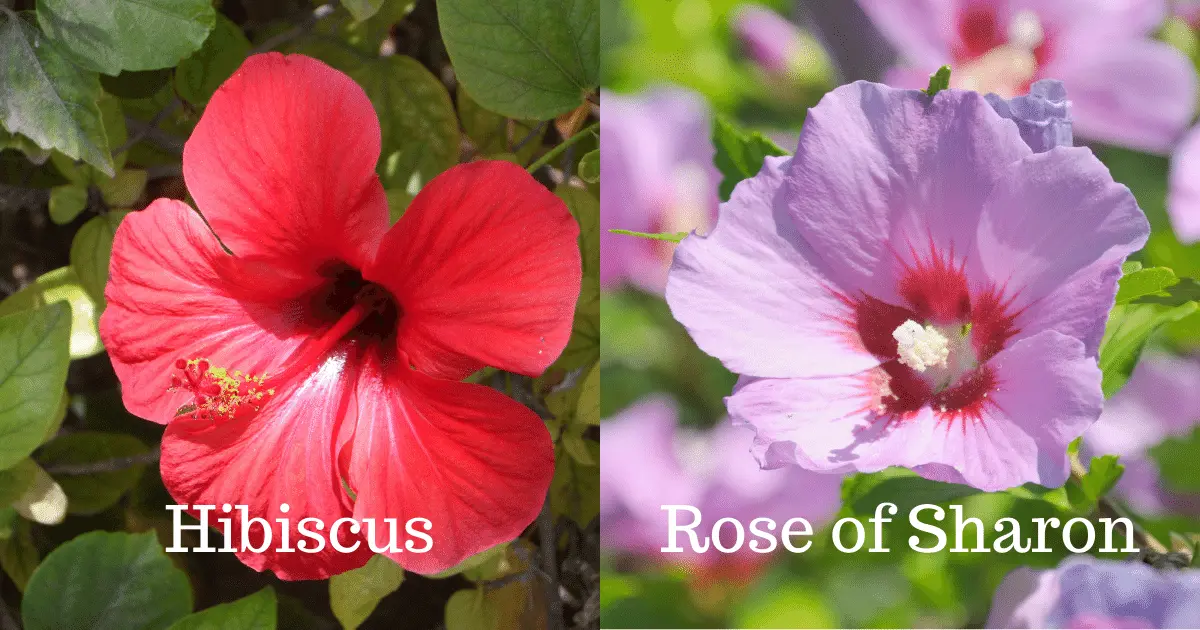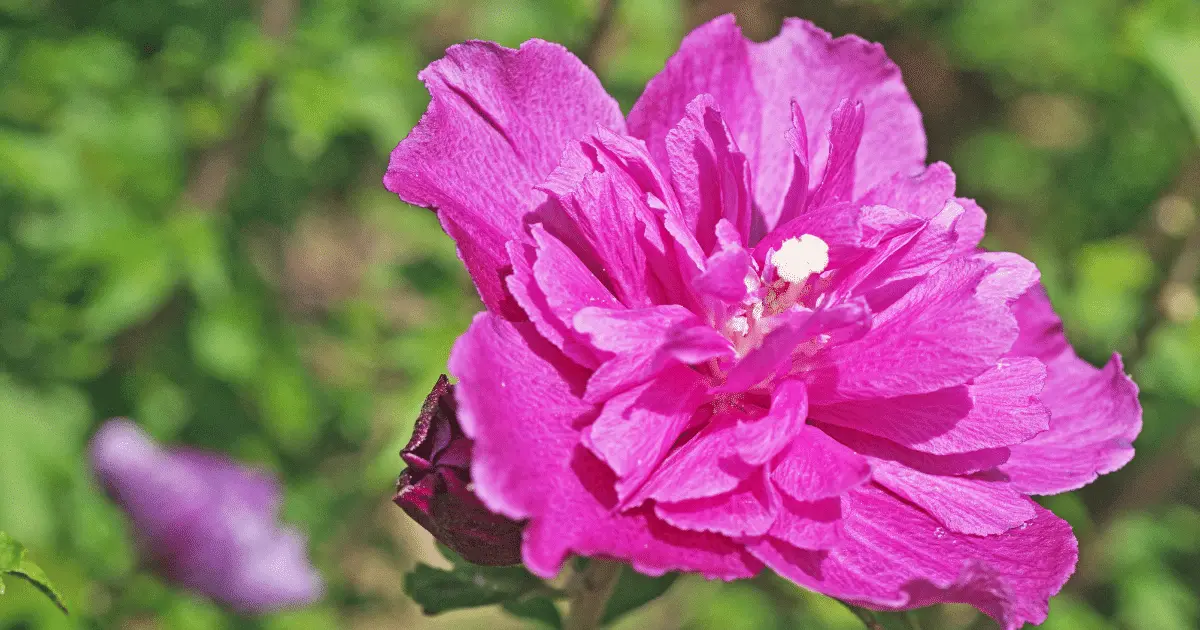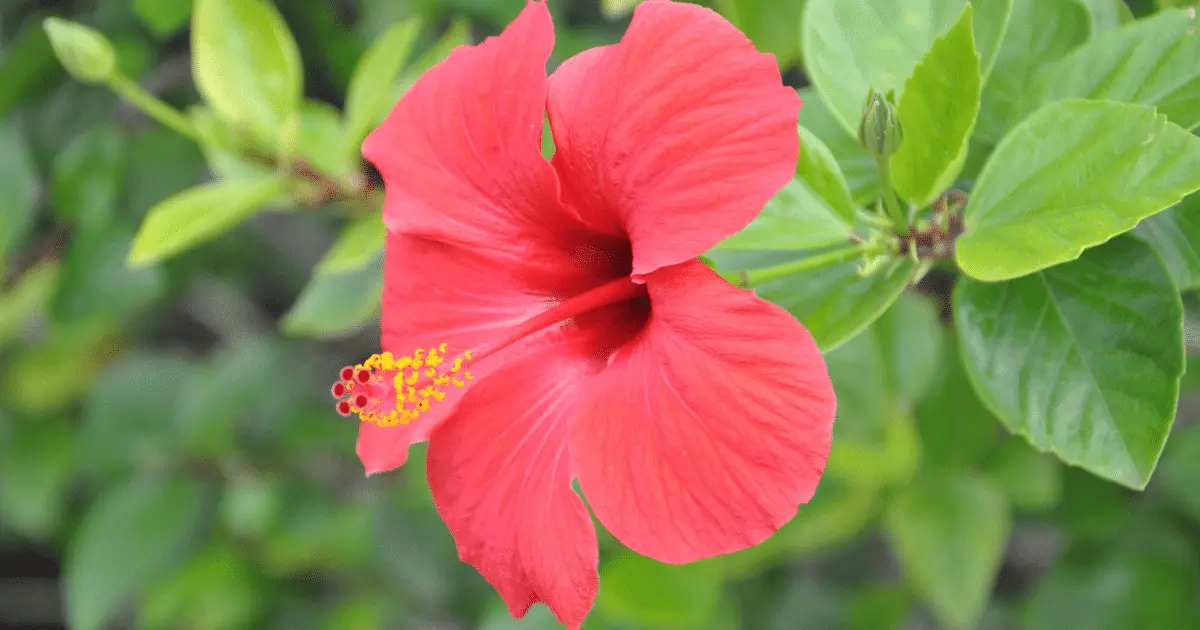Rose of Sharon and Hibiscus are exotic flowering plants that add a touch of tropics to every garden landscape. While the plants look similar, they are from different climates and thrive in different places.
Rose of Sharon vs. Hibiscus

Rose of Sharon ( Hibiscus syriacus), also called Shrub Althea, shrub, or small tree is arguably the most popular Hibiscus species. It is a woody shrub that grows 8-10 feet tall and 6-10 feet wide.
This flowering plant is valuable because it flowers in late summer to fall when few other plants bloom. Each flower lasts only for a day or two when it blooms, but there are so many flowers that the shrub remains in bloom for a few weeks.
According to All Gardening, the traditionally labeled ” Hibiscus ” plant is the Chinese Hibiscus (Hibiscus rosa-Sinensis). It is a rounded, woody, evergreen shrub or small tree with lance-shaped, glossy dark green leaves with toothed margins. It is prized for its glossy foliage and numerous exotic-looking flowers. The flowers range from 4 to 8 inches in diameter, maybe double or single.
| Rose of Sharon | Hibiscus | |
| Common Name | Rose of Sharon, Shrub Althea, Rose mallow, Syrian mallow, Syrian Hibiscus | Tropical hibiscus, Chinese hibiscus, China rose, |
| Botanical Name | Hibiscus syriacus | Hibiscus rosa-Sinensis |
| Family | Mallow family (Malvaceae) | Mallow family (Malvaceae) |
| Plant type | Shrub | Shrub |
| Mature Size | 8-12 ft tall, 6-10 ft tall | 4-10 ft tall, 3-6 ft wide |
| Sun exposure | Full, partial | Full sun, partial shade |
| Soil type | Moist, well-drained | Moist, well-drained |
| Soil pH | Acidic, neutral | Acidic |
| Bloom time | Summer, fall | Summer, fall |
| Flower color | Pink, purple, lavender, red | White, red, pink, orange, yellow, purple |
| Hardiness zones | 5-8 USDA | 9-12 USDA |
| Native area | Asia | Asia |
Both plants are cousins and are members of the mallow family, a large group of several hundred different plant species. Horticulturists and breeders have developed numerous cultivars of both shrubs, increasing the number of ornamental plants with particularly showy flower colors.
The plants’ names were bestowed by Carl Linnaeus, the Swedish botanist responsible for the plant taxonomy system we still use today. They were also named after their origins of discovery, namely China and Syria.
Appearance
Rose of Sharon features rows of purple, pink and white flowers from top to bottom. The flowers also have a stark red center which resembles a bullseye. Hibiscus flowers have a more physical appearance.
The flowers come in blindingly bright colors like that of Island sunsets. Classic red is one of the most common color varieties, but the flowers can also come in bright yellow, orange, pink, or a mix of them in one vivid flower.
In a nutshell, the flowers of these two species often look similar but can be differentiated by their color. Therefore, if the flowers are bright and intense, they are Hibiscus species, while if they are muted with red centers, they are rose of Sharon.
Cultivars
Each plant features a set of specialized cultivars with unique attributes. For the rose of Sharon, there are a number of cultivars that bloom from August to October. If you are landscaping your garden, these shrubs can provide wonderful color and privacy. Some of these cultivars include; White Chiffon, Aphrodite Althea, Minerva, Hibiscus Syriacus, Rose mallow-Hibiscus Syriacus Duc de Brabant, etc.
Hibiscus cultivars come in bright floral colors. They include; the ‘Painted Lady’ Cultivar, ‘El Capitolto, and the stunning sunset cultivar ‘Fiesta.’
How To Grow
Rose of Sharon

Rose of Sharon and its varieties are easy to grow because they can withstand harsh conditions like frost, drought, heat, and dry soil. However, the plant grows best in moist soil that drains well. You can grow from the rose of Sharon seedlings.
Each bush produces many seed pods that can take root easily, and the plant is considered invasive. If you add this specie to your garden, ensure you plant them in spring or fall.
Just because they are a good hedge plant, plant them 6 to 10 feet (1.8- 3m) apart, depending on your landscaping goals. You can also grow them by planting the seeds outdoors in late winter, about 12 weeks before the last frost date.
Hibiscus

Hibiscus is very easy to grow. The best time to plant this specie in the garden is in the spring, at the start of the growing season. It has four basic requirements to grow healthy and bloom well.
They include sun and warmth, excellent drainage, ample moisture, and nutrients. Set your Hibiscus in the planting hole for optimal growth, so the stem stays at the soil surface. If necessary, add backfill soil to the bottom of the hole to achieve proper planting height.
Then spread mulch around the plant to retain moisture in and weeds out. This will provide winter protection for the roots.
Uses
The flowers of these species are edible and come with a range of health benefits. Research has proven the benefits of this flower for diarrhea, dysentery, abdominal pain, leucorrhea, dysmenorrheal, dermatophytosis, skin diseases, dizziness, and bloody stools.
It can also be used to make tea or produce hibiscus extract. Alternatively, the large blooms of the flowers can be used to decorate desserts or salads for a delicious botanical feature.
How To Care
Both species have similar care requirements with some differences in watering requirements.
Light
Rose of Sharon specie thrives best with just a few hours of direct sunlight daily. Hibiscus grows in tropical climates with hot weather, so they do not need as much sunlight to bloom as the rose of Sharon.
Soil & fertilizing
Both species are not fussy about soil; they grow best in rich, loamy, and poorer soils. Rose of Sharon can handle some dry soil before their next watering.
However, due to higher temperatures, Hibiscus prefers consistently moist but not waterlogged soil to keep the plants healthy and the roots cool. For the best result, a slow-release fertilizer can be applied once a season or a liquid fertilizer once a month.
Maintenance
For both plants, pruning and mulching are the two main maintenance tasks. Mulching helps retain moisture and keep weeds down while keeping your plants well-fed. While pruning keeps the shrubs tidy and promotes flowering.
Climates
Climate is the main difference between these two species. Rose of Sharon specie survives in various climates, providing options for lovers of exotic tropical flowers living in non-tropical areas.
On the other hand, Hibiscus requires a tropical environment to thrive. They are grown in USDA zones 10 and 11 but can tolerate zone 9 if given some protection.
Common Pests and Diseases
Generally, rose of Sharon is loved for its large, prolific, tropical-looking blooms in late summer. Besides this, these flowers are attractive to bees, butterflies, and hummingbirds. Unfortunately, they are also attracted to Japanese beetles and root-knot nematodes.
These pests can cause large holes, knots, or galls in the plants’ underground roots. The galls disrupt the plant’s ability to take up water or nutrients, causing the aerial parts of the plant to die slowly. Some other lesser known pest and disease of rose Sharon plants includes gray mold, powdery mildew, cotton root rot, and cankers.
Hibiscus is free of pests and diseases but may encounter spider mites and aphids, especially if you bring the plant indoors. You can remove all insects using neem oil or forcefully spray the plant with water.
